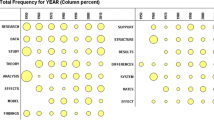Abstract
We have developed a method to identify and map the internationally most visible research topics occurring in the social and behavioral sciences, as well as the topics which changed most over a decade. Methods and data relevent to a portfolio analysis of national research efforts are described. Keywords used by authors in scientific or scholarly publications provide a window on scientific developments and changes in scientific research. Using an interdisciplinary database, the SSCI, developments in publications were traced world-wide and for the US, UK, France, Germany, and the Netherlands. We compared two periods: 1981–85 and 1986–90 We discuss the major substantive developments occurring during 1981–1990, as visible in maps depicting both topics and disciplines. It is shown that the maps, enriched with scientometric indicators of strengths and weaknesses of national research efforts, can be important tools for science policy. The findings indicate that the research front on many topics in both social and behavioral sciences is international in the late 1980s.
Similar content being viewed by others
References
M. Callon, J. Law, A. Rip (Eds),Mapping the dynamics of science and technology. Houndmills, MacMillan, 1986.
W. A. Turner, G. Chartron, F. Laville, B. Michelet, Packaging information for peer review: new co-word analysis techniques. In:A.F.J. Van Raan (Eds),Handbook of Quantitative Studies of Science and Technology. Amsterdam: Elsevier Science Publishers, 1988, 291–323.
P. Vandenesselaar, L. Leydesdorff, Mapping change in scientific, specialties: A scientometric reconstruction of the development of artificial intelligence.,Journal of the American Society for Information Science, 47 (1996) 415–436.
E. Garfield,Citation Indexing. John Wiley & Sons, New York, 1979.
R. R. Braam,Mapping of science: Foci of intellectual interest in scientific literature. Leiden: DSWO Press, 1991.
H. P. F. Peters, A. F. J. Van Raan, Co-word based science maps of chemical engineering. Part I: Representations by direct multi-dimensional scaling.Research Policy, 22 (1993) 23–45.
A. Rip, Mapping of science: possibilities and limitations. In:A.F.J. Van Raan (Ed.),Handbook of Quantitative Studies of Science and Technology. Amsterdam: Elsevier Science Publishers., 1988, 253–273.
A. Rip, J. P. Courtial, Co-word maps of biotechnology: An example of cognitive scientometrics.Scientometrics, 6 (1984) 381–400.
R. J. W. Tijssen.Cartography of science: scientometric mapping with multidimensional scaling methods. Leiden: DSWO Press, 1992.
A. J. Nederhof,Developments in asthma- and COPD- related research 1981–1990. Report Leiden: CWTS-92-02, 1992.
A. J. Nederhof, E. C. M. Noyons,Trends in publication and international co-publication activity in the social and behavioral sciences and the humanities (1984–1989). Report Leiden: CWTS-90-05, 1990.
A. J. Nederhof, R. A. Zwaan, Quality judgements of journals as indicators of research performance in the humanities and the social and behavioral sciences.Journal of the American Society for Information Science, 42 (1991) 332–340.
A. J. Nederhof, R. A. Zwaan, R. E. de Bruin, P. J. Dekker, Assessing the usefulness of bibliometric indicators for the humanities and the social sciences,Scientometrics, 15 (1989) 423–435.
SAS Institute Inc., SAS/STATUser's Guide, version 6 fourth edition volume I. Cary, NC: SAS institute Inc, 1990.
J. C. Doré, T. Ojasoo, Y. Okubo, T. Durand, G. Dudognon, J. Miquel, Correspondence factor analysis of the publication, patterns of 48 countries over the period 1981–1992.Journal of the American Society for Information Science, 47 (1996) 588–602.
L. Lebart, A. Morineau, K. M. Warwick,Multivariate descriptive statistical analysis, New York: Wiley, 1984.
H. M. Moed, R. E. de Bruin, T. N. Van Leeuwen, New, bibliometric tools for the assessment of national research performance: database description, overview of indicators and first applications.Scientometrics, 33 (1995) 381–422.
A. J. Nederhof, A. G. Zwier, The “crisis” in social psychology: An empirical approach.European Journal of Social Psychology, 13 (1983) 255–280.
P. G. M. VanderHeiden, K. Sijtsma, Fifty years of measurement and scaling in the Dutch social sciences.Statistica Neerlandica, 50 (1996) 111–135.
A. J. Nederhof, E. Van Wijk,Static and dynamic bibliometric maps of the social and behavioral sciences: Positioning the Netherlands. Report Leiden:CWTS-95-04, 1995.
R. Nisbett, L. Ross,Human inference: strategies and shortcomings of social judgement. Englewood Cliffs, New Jersey: Prentice Hall, 1980, p. 45.
A. J. Nederhof, Books and Chapters are not to be neglected in measuring research productivity.American Psychologist, 44 (1989) 734–735.
A. J. Nederhof, A Comparison of European and North American response patterns in mail surveys.Journal of the Market Research Society, 27 (1985) 55–63.
J. Vala, M. L. Lima, A. Caetano, Mapping European social psychology: Co-word analysis of the communications of the 10th General Meeting of the EAESP.European Journal of Social Psychology, 26 (1996) 845–850.
L. Leydesdorff, Words and co-words as indicators of intellectual organization.Research Policy, 18 (1989) 209–223.
Author information
Authors and Affiliations
Rights and permissions
About this article
Cite this article
Nederhof, A.J., Van Wijk, E. Mapping the social and behavioral sciences world-wide: Use of maps in portfolio analysis of national research efforts. Scientometrics 40, 237–276 (1997). https://doi.org/10.1007/BF02457439
Received:
Issue Date:
DOI: https://doi.org/10.1007/BF02457439




